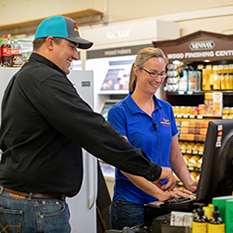Retail Technology – From Innovation to Necessity
Retail technology has long been a part of the industry’s evolution. It all began in 1879 when James Ritty, an Ohio saloon owner, patented the first cash register. Since then, innovations like computerized registers, modern point-of-sale (POS) systems, credit and debit card processing, and e-commerce have steadily transformed how retailers operate.
But it was the COVID-19 pandemic that truly accelerated the adoption of retail technology. Businesses that had already embraced digital tools—such as inventory management systems and omnichannel sales platforms—were better equipped to weather the storm. Solutions like buy online, pick up in-store (BOPIS), curbside pickup, and delivery services became lifelines for both retailers and customers.
THE NUMBERS TELL THE STORY
According to the U.S. Chamber of Commerce’s annual report, Empowering Small Business: The Impact of Technology on U.S. Small Business:
99% of small businesses now use at least one technology platform
81% plan to increase their use of technology platforms
79% reported that technology helped them avoid raising prices for consumers during a period of high inflation
40% said they used generative AI in 2024, nearly double from the previous year
Technology isn’t just a convenience—it’s a competitive advantage. It streamlines operations, reduces costs, and enhances customer service, all of which contribute to business growth.
TECHNOLOGY IS THE FOUNDATION OF MODERN RETAIL
“The best tools equate to the best results,” says Dan Nesmith, founder and president of Paladin Data Corporation, a leader in retail technology solutions. “Technology supports store success by providing sophisticated forecasting models that automatically tailor inventory to customer demand.”

Buffalo Hardware owner Sam Olson works with an employee on the store’s point-of-sale system.
At the heart of this transformation is the point-of-sale system. A modern POS does more than ring up sales—it integrates data from across the business to improve efficiency. But it must also be intuitive. Store associates, regardless of their tech skills, need to use it with ease.
Sam Olson, owner of Buffalo Hardware in South Dakota, shares his experience:
“We had to overcome an employee fear level—some had no computer skills at all. With Paladin’s touchscreen simplicity, just about anyone can use it. That was huge for us.”
Ease of use translates directly into better customer experiences. Faster checkouts and fewer clicks per transaction mean shorter lines and happier shoppers.
SMARTER INVENTORY, SEAMLESS SALES
Advanced inventory management systems can:
Track stock levels in real time
Recommend reorders
Compare supplier prices
Split and send purchase orders automatically
Alert retailers to supplier stock availability
And with the rise of online shopping, POS systems must handle both in-store and digital transactions while keeping inventory accurate across all channels. This reduces out-of-stocks, boosts sales, and improves profit margins.
As Nesmith puts it, “Retail technology isn’t just about keeping up—it’s about staying ahead.”
ONLINE RETAIL: A MUST-HAVE FOR MODERN STORES
Online retail is no longer a luxury—it’s a necessity. While the pandemic may have sparked a surge in web shopping, the trend is here to stay. Experts predict global e-commerce sales will soar to $8.09 trillion by 2028, making it clear: retailers who want to stay competitive must have a strong online presence.
Yet many independent retailers still hesitate. Common concerns include cost, lack of technical know-how, or the belief that a website isn’t relevant to their business. Some rely solely on social media as their digital storefront. That’s where PaladinShop™ comes in—a digital store built into Paladin Point of Sale that removes the traditional barriers to going online.

Jenn and Luke Bates use Paladin POS and PaladinShop to better serve their customers.
MAKING ONLINE RETAIL EASY FOR SMALL BUSINESSES
PaladinShop empowers small retailers like Jenn and Luke Bates, who own ProTrade Hardware & BBQ Supply in Somerset, Kentucky, to launch a fully functional online store—without the high costs or complexity of traditional platforms. It includes customer self-service tools for account management and payments, along with a digital storefront that showcases products in detail.
“We’re a true mom-and-pop store. So, if we do something like this, it’s up to us,” Jenn shares. “We’re super new at this, but it’s launched—and people are browsing, paying bills, and exploring the site.”
And it’s not just about online sales. Retailers without a website are missing out on visibility. Studies show that 80% of consumers research small businesses online before visiting in person—and half of them visit within a day of searching.
OMNICHANNEL IS THE NEW NORMAL
Today’s shoppers expect a seamless experience across all channels. Many even browse a store’s website while shopping in person. According to PYMNTS.com, 34% of shoppers use their smartphones in-store to compare prices, find deals, read reviews, or locate products.
Retailers need to think beyond the register. As Paladin’s Nesmith puts it: “Merchants must embrace all that technology offers—loyalty programs, geofencing, automated surveys, mobile-friendly portals, digital ads, and secure in-store Wi-Fi. A POS system is just one part of a complete business intelligence solution.”
UPSHOT
Retail is evolving fast, and customer expectations are higher than ever. E-commerce and omnichannel strategies aren’t just trends—they’re essential tools for:
Saving time
Boosting efficiency and profits
Enhancing customer service
Managing operations more effectively
By embracing digital transformation, retailers can simplify their workflows and position themselves for long-term success.
brian bullock
Author


